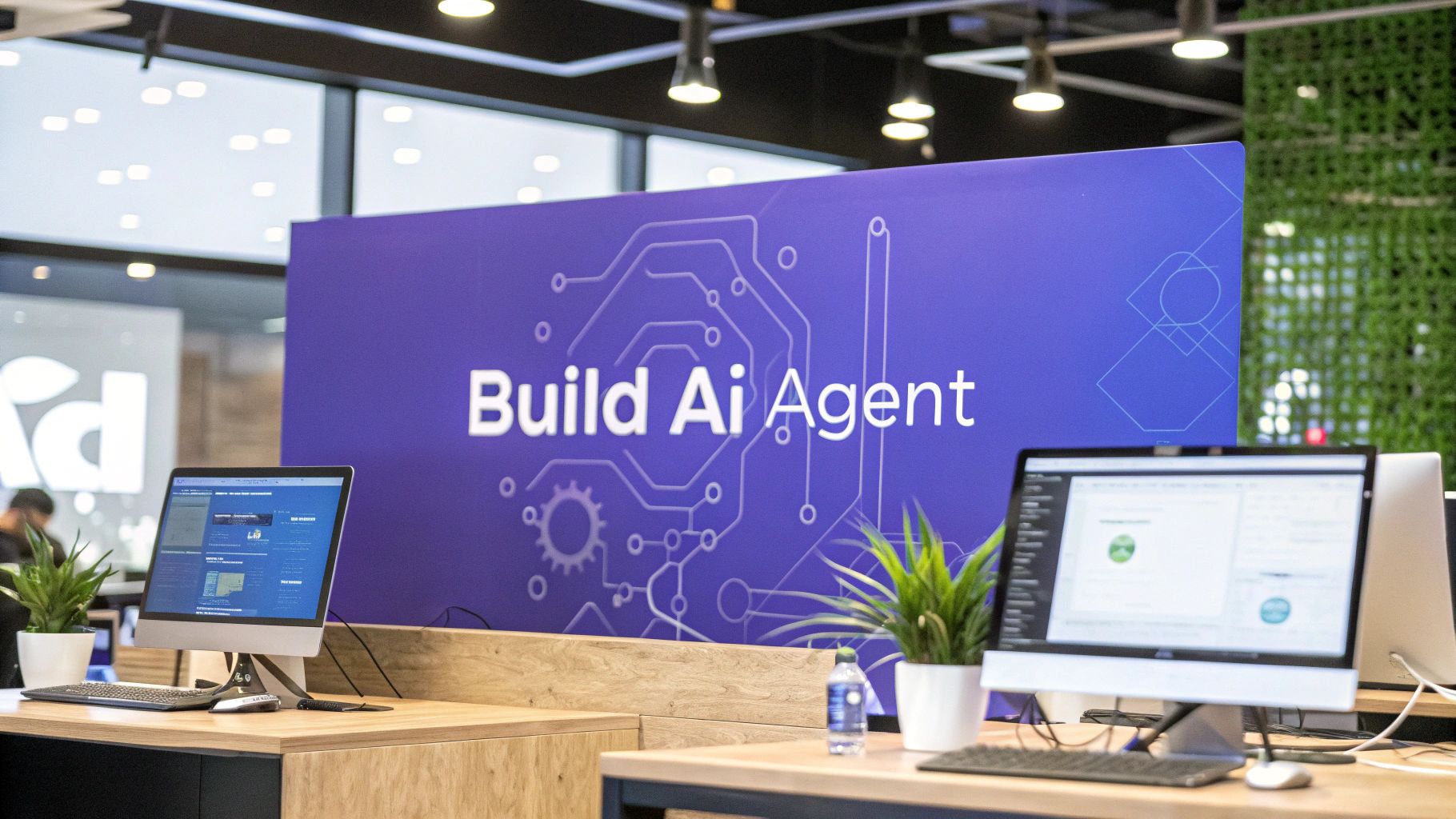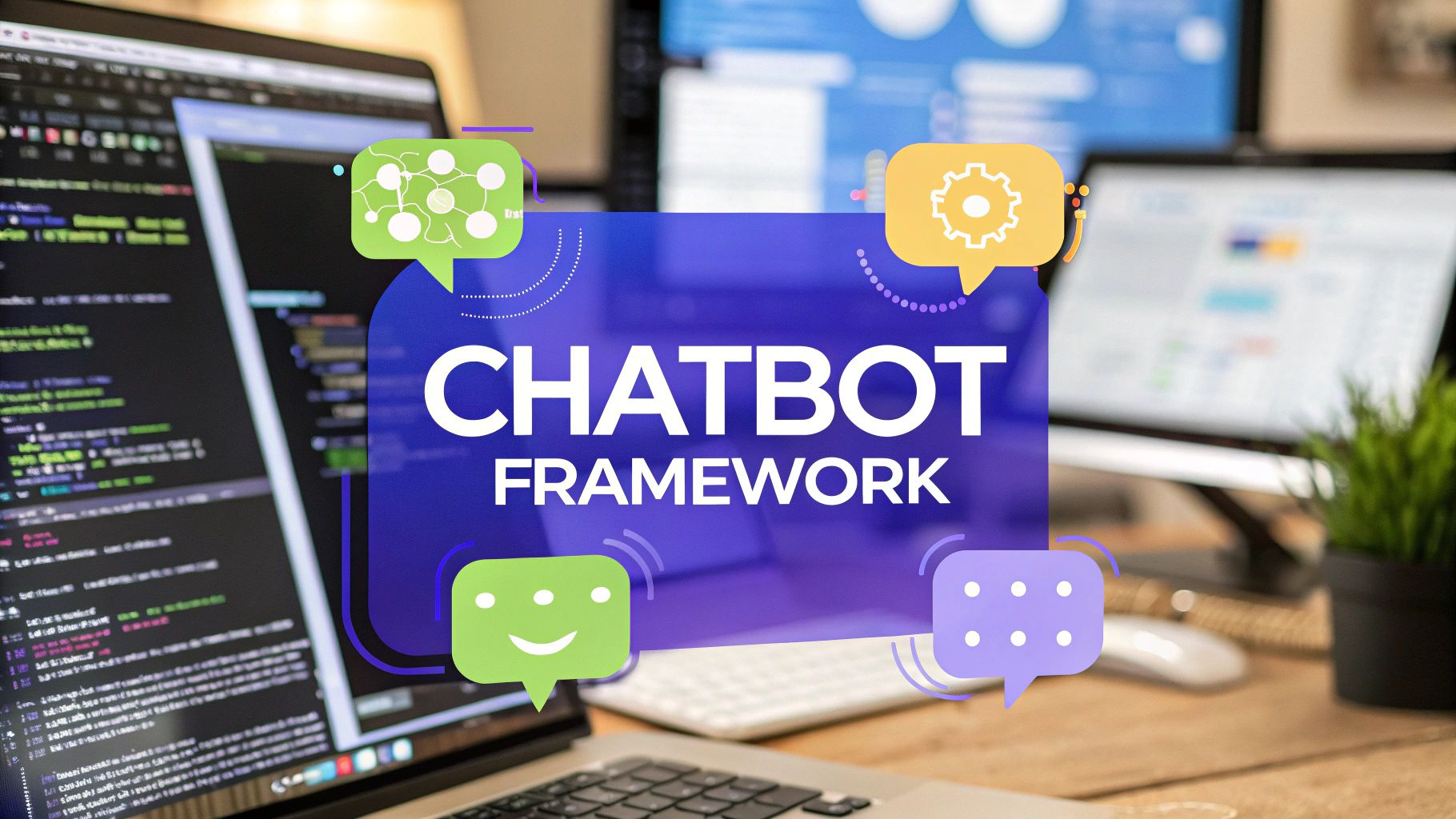Top Canned Response Examples to Boost Customer Support
Explore 8 effective canned response examples to save time and ensure consistent communication in customer support and sales.
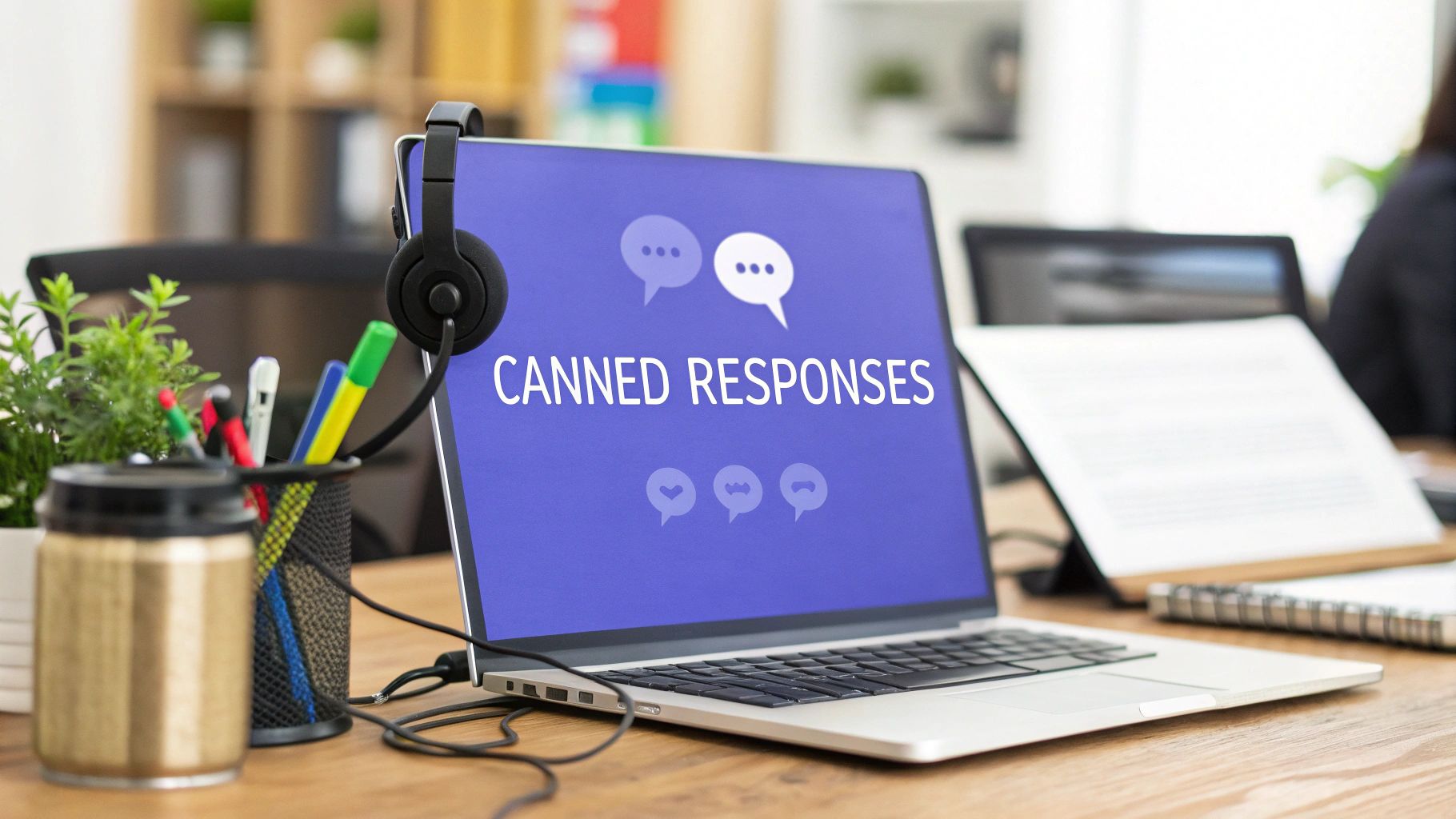
Canned responses are a useful tool for any team communicating with customers. They offer a way to deliver consistent, accurate, and quick answers. When used thoughtfully, these pre-written messages free up your team to focus on more complex problems that require a human touch.
This article provides practical, real-world canned response examples across various situations, from acknowledging a new ticket to handling a delicate escalation. We will look at why each template works, how to customize it for your brand, and the strategic thinking behind its structure. For those aiming to refine their overall communication approach, exploring essential business writing tips can significantly improve the effectiveness of your pre-written responses.
The goal is to move from robotic replies to efficient, personalized communication that strengthens customer relationships. We will explore how platforms like Chatiant can help automate and manage these responses, integrating them directly into your workflow with tools like AI agents and chatbots trained on your data. This approach helps maintain quality while scaling your support and sales operations. By the end of this guide, you will have a playbook of templates and the strategic knowledge to implement them effectively.
1. Acknowledgment Canned Response
An acknowledgment canned response is an automated, immediate reply sent to a customer upon receiving their inquiry. Its primary function is to confirm receipt of the message. This confirmation instantly reduces customer anxiety and sets clear expectations for when they can anticipate a personal follow-up. This type of message is a foundational element of a strong customer support system, acting as the first, reassuring touchpoint in the service journey.
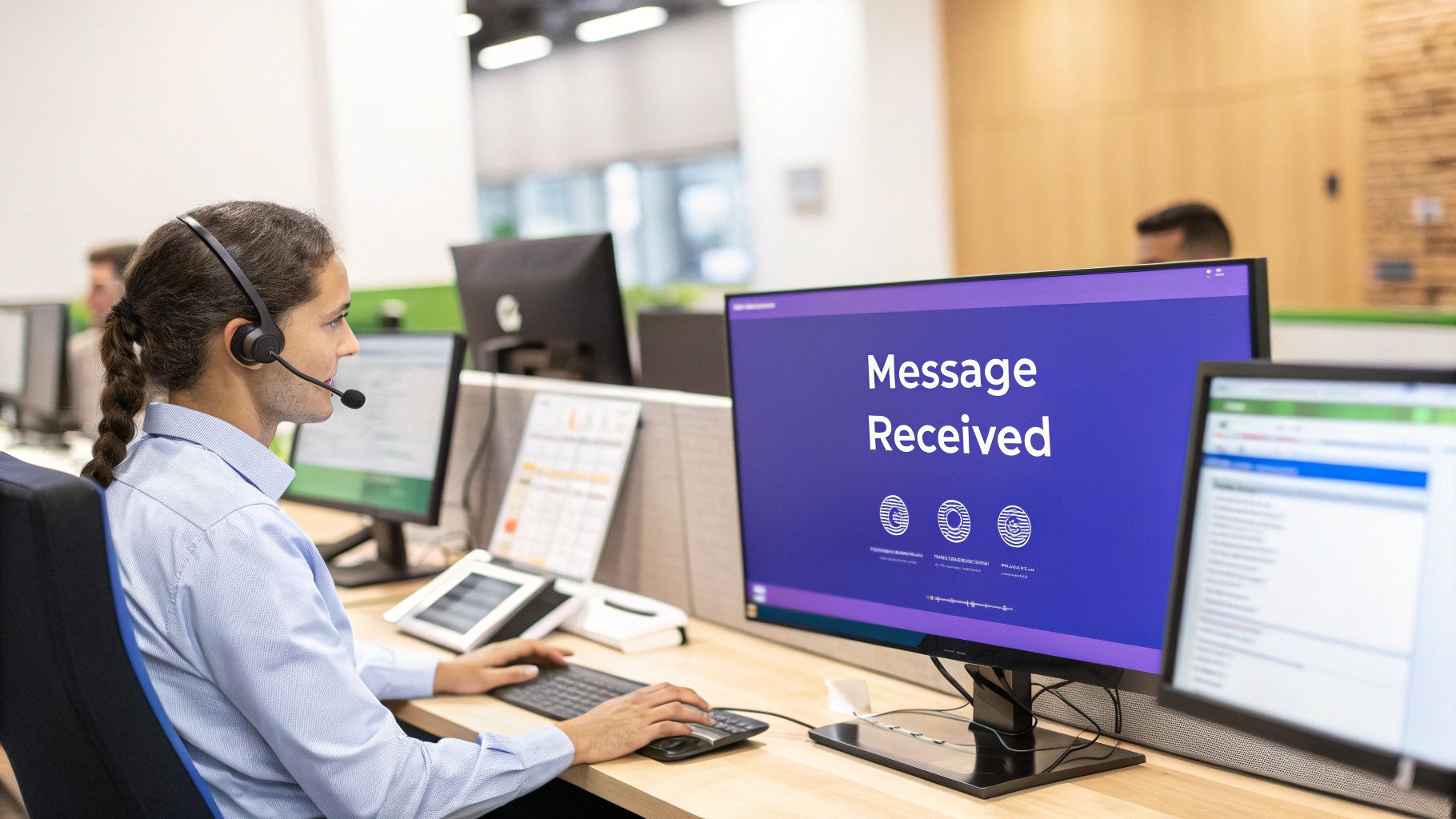
This method, popularized by platforms like Zendesk and Freshdesk, builds immediate trust. Instead of leaving a customer wondering if their email disappeared into a digital void, the acknowledgment response validates their action and provides a clear path forward. It is a simple yet powerful tool for managing perceptions and starting the support interaction on a positive note.
Strategic Breakdown
The effectiveness of this canned response example lies in its ability to control the narrative from the very first second. By providing a timeline, you prevent customer frustration and reduce the likelihood of them sending duplicate inquiries.
- Key Insight: This response transforms a moment of potential uncertainty into an opportunity for reassurance.
- Strategic Goal: Manage customer expectations, reduce support ticket volume from repeat inquiries, and establish a professional, organized first impression.
- When to Use: Implement this for all inbound communication channels, including support emails, contact forms, and secure messaging portals. It is a basic requirement for any business that receives customer inquiries online.
Pro Tip: Use your help desk software's automation rules (or "triggers") to send these acknowledgments instantly. The value diminishes significantly if there is a delay between the customer's submission and your confirmation.
Actionable Takeaways
To create an effective acknowledgment response, focus on clarity and helpfulness.
- Be Specific with Timelines: Instead of saying "soon," state a clear timeframe like, "Our team will get back to you within 24 business hours."
- Offer Self-Service Options: Include a link to your FAQ or knowledge base. This can solve the customer's problem immediately, closing the ticket before an agent even sees it.
- Personalize When Possible: Use automation tokens like
{{customer.name}}to add a personal touch. A simple "Hi Jane," is much warmer than "Dear Customer."
2. FAQ-Based Canned Response
An FAQ-based canned response is a pre-written reply that directly answers a common customer question. Its main purpose is to deliver a fast, accurate, and complete solution to recurring issues. This frees up support agents to focus on more involved problems. This approach is a cornerstone of efficient customer service, allowing teams to resolve a high volume of tickets with minimal effort.
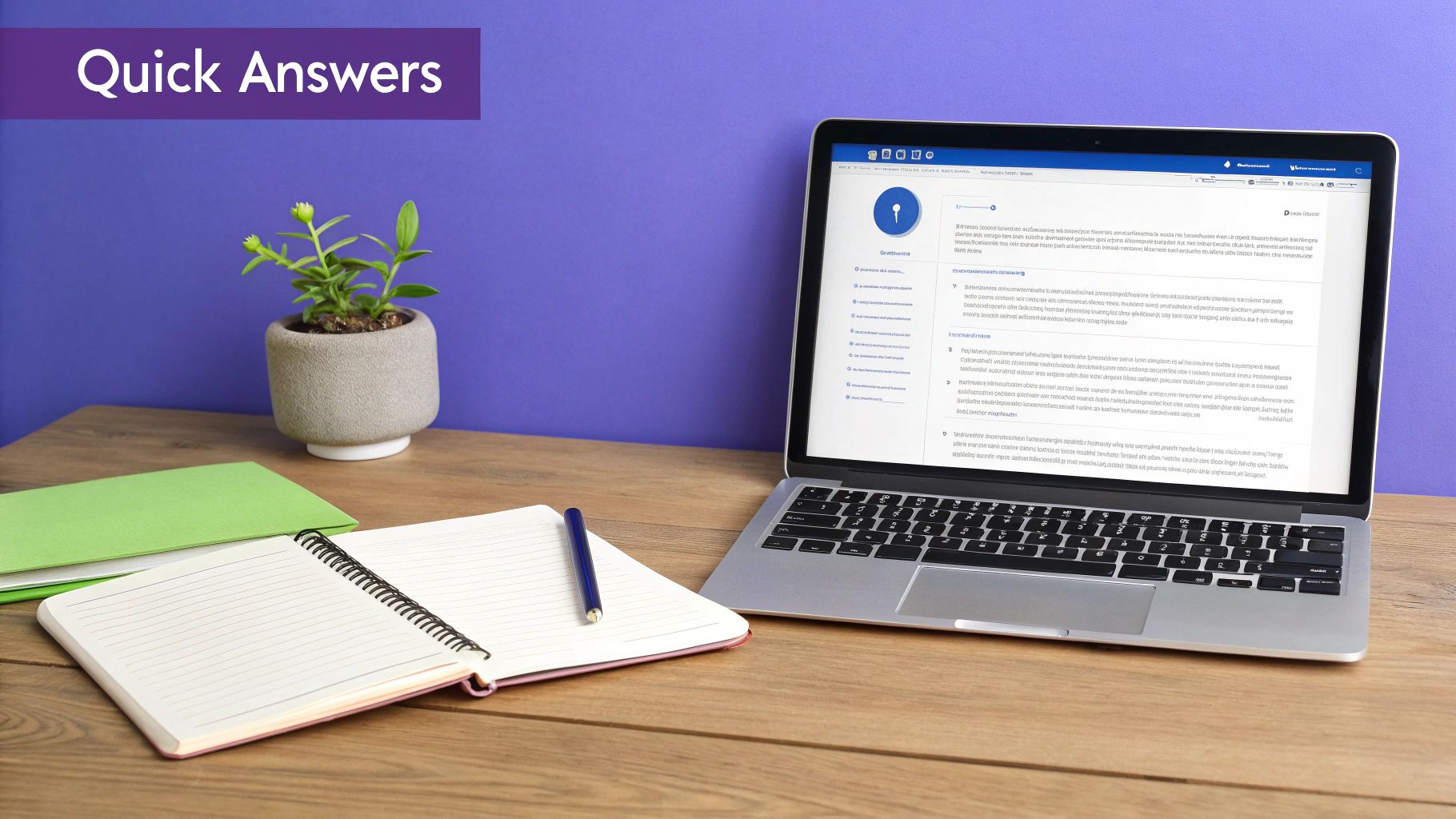
This method, championed by platforms like HubSpot and Intercom, systemizes knowledge delivery. Instead of having agents rewrite answers to questions about return policies or software setup, a well-crafted template provides consistency and speed. These canned response examples are powerful tools for scaling support operations without sacrificing quality.
Strategic Breakdown
The power of this response comes from its efficiency and its ability to give customers immediate answers. By identifying and documenting solutions to the most common inquiries, you build an internal knowledge library that directly fuels your external support.
- Key Insight: This transforms repetitive support tasks into an opportunity for instant problem resolution, improving both agent productivity and customer satisfaction.
- Strategic Goal: Reduce average response and resolution times, make sure consistent and accurate information is shared, and lower the operational cost of the support function.
- When to Use: Apply this for any question that appears repeatedly in your support channels. It is ideal for inquiries related to shipping, returns, account settings, billing, or basic troubleshooting steps.
Pro Tip: Use your support ticket data to create a "Top 10" list of frequently asked questions each month. This keeps your FAQ-based responses relevant and addressing the most pressing, high-volume customer needs.
Actionable Takeaways
To make your FAQ responses effective, they must be both complete and easy to digest.
- Improve with Visuals: Include screenshots, GIFs, or short video links to guide users through steps. Visual aids make complex instructions much easier to follow.
- Anticipate the Next Question: A great FAQ response answers the initial query and links to related articles or next steps. For a "how to reset password" query, link to an article on "how to enable two-factor authentication."
- Personalize and Frame the Answer: Always use the customer's name. Start the response by rephrasing their question to show you have understood their issue before providing the templated answer.
3. Escalation Canned Response
An escalation canned response is a carefully prepared message used when a customer's issue must be transferred to a higher support tier, a specialized department, or management. Its purpose is to manage the transition smoothly, explaining why the transfer is necessary and what the customer should expect next. This response prevents the customer from feeling passed around and reframes the escalation as a positive step toward a resolution.
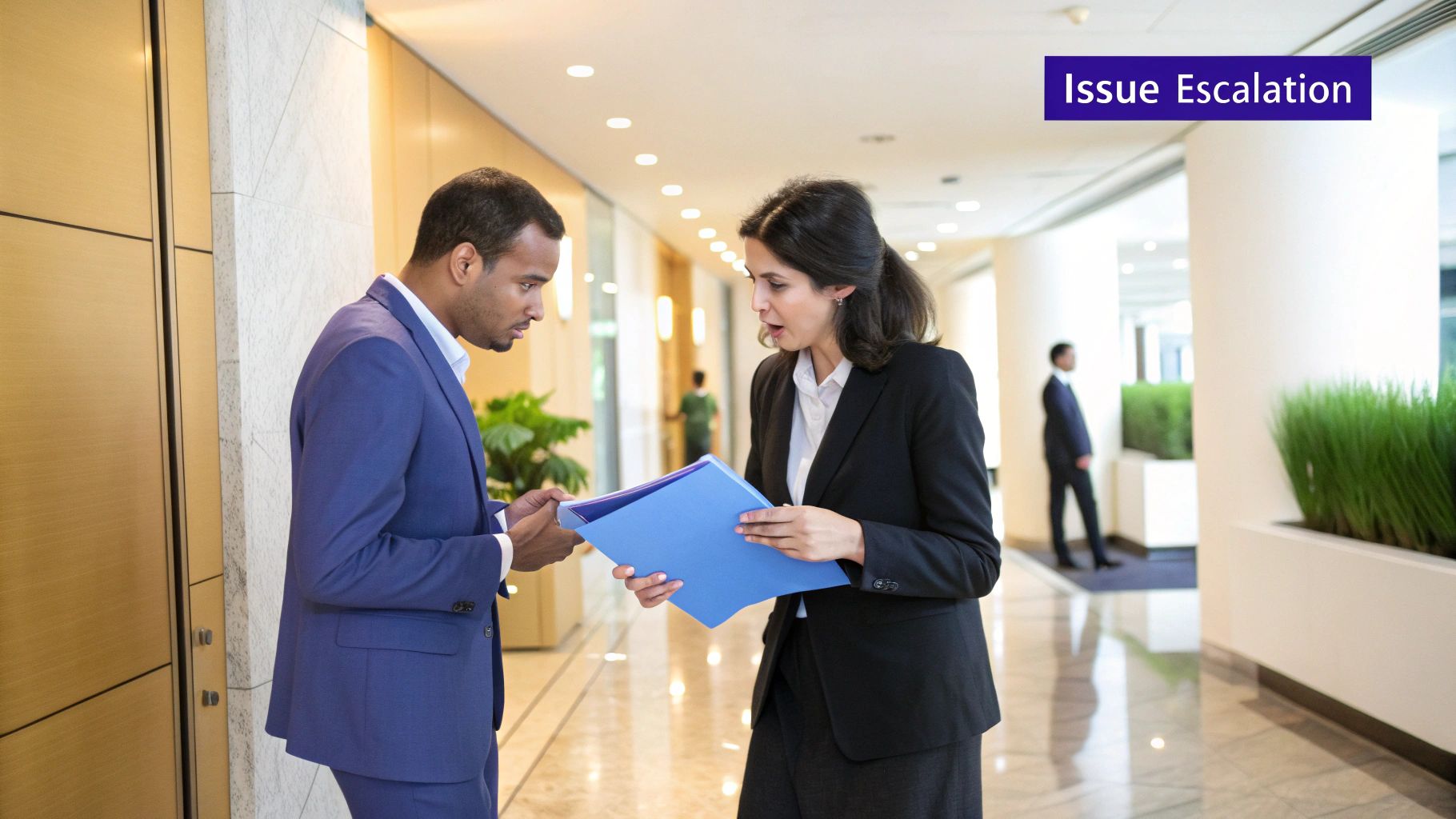
This practice, common in platforms like JIRA Service Management and ServiceNow, is important for maintaining customer confidence during difficult problem-solving. Instead of a dead end, the customer sees a clear, logical progression. It demonstrates that the support system has a defined process for handling advanced problems, from technical bugs needing an engineering team to billing disputes requiring the accounting department.
Strategic Breakdown
The strength of this canned response example is its ability to maintain control and transparency during a handoff. By clearly articulating the "why" and "what's next," you turn a potential point of friction into a showcase of your company's internal collaboration and commitment to resolution.
- Key Insight: This response reassures the customer that their problem is being taken seriously and moved to the person best equipped to solve it.
- Strategic Goal: Retain customer trust during internal transfers, provide a seamless handoff experience, and reduce follow-up inquiries by setting clear, new expectations.
- When to Use: Use this template when a front-line agent cannot resolve an issue due to its complexity, scope, or need for specific departmental authority. It is critical for multi-tiered support structures.
Pro Tip: Include a brief, non-technical summary of the issue and the steps already taken. This shows the customer you’ve listened and saves the next agent from asking repetitive questions.
Actionable Takeaways
To build an effective escalation message, prioritize transparency and reassurance.
- Explain the Benefit: Frame the escalation positively. For example, say, "To resolve this for you, I am escalating your ticket to our senior technical team, who have specialized tools to investigate this further."
- Provide a Reference ID: Always include the ticket or case number. This gives the customer a concrete reference point for all future communication regarding the issue.
- Set a New Timeline: The original response time no longer applies. Give a realistic new timeframe for when the specialist or new department will reach out. You can learn more about help desk best practices on chatiant.com for additional insights.
4. Apology and Resolution Canned Response
An apology and resolution canned response is a carefully prepared message used to acknowledge a mistake, accept responsibility, and outline a clear solution. Its main purpose is to de-escalate customer frustration and begin rebuilding trust after a service failure, such as an order error or a technical outage. This type of response shows accountability and lets customers know you value their business.
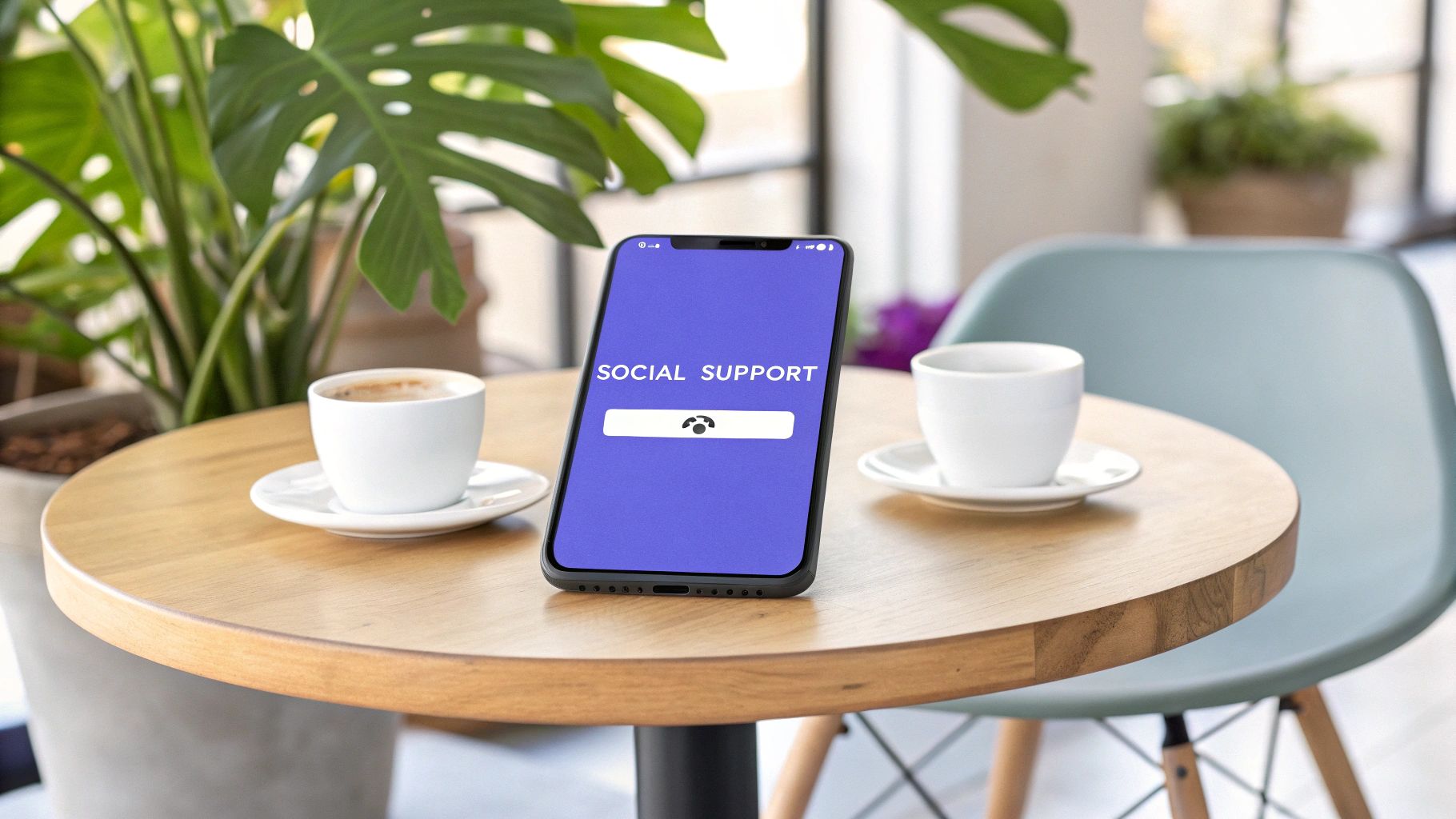
This approach was popularized by companies like Zappos and Buffer, which are famous for their transparent, customer-centric communication. Instead of deflecting blame, these responses tackle the problem head-on, balancing genuine empathy with a practical fix. This transforms a negative experience into an opportunity to showcase exceptional customer care and reinforce loyalty.
Strategic Breakdown
The power of these canned response examples comes from their ability to shift the dynamic from conflict to collaboration. By sincerely apologizing and immediately offering a solution, you validate the customer's feelings and demonstrate a commitment to making things right. This is a core component of a strong service recovery strategy.
- Key Insight: A well-handled apology can be more memorable than a flawless transaction.
- Strategic Goal: Retain customer loyalty, mitigate negative reviews, and turn a service failure into a positive brand interaction.
- When to Use: Use this for any situation where your company is at fault, including shipping delays, product defects, billing errors, or service outages. It's a vital tool for any team that interacts with customers post-purchase.
Pro Tip: Give your support agents the autonomy to offer pre-approved compensation, such as a discount code or account credit. This allows for a swift, one-touch resolution without needing manager approval.
Actionable Takeaways
To make your apology and resolution response effective, focus on empathy, clarity, and action.
- Use Empathetic Language: Start by explicitly stating "we apologize" or "we're sorry." Acknowledge the specific inconvenience, like, "We are sorry for the frustration our system outage has caused."
- Provide a Concrete Solution: Clearly state the action you are taking. For example, "We have already shipped a replacement order via expedited shipping," is better than, "We will look into this."
- Offer Appropriate Compensation: Adjust the compensation to the severity of the issue. A small discount might work for a minor delay, while a major error may require a more significant gesture. These actions are often managed with tools discussed in customer support automation.
5. Product Information Canned Response
A product information canned response provides complete details about a product or service. Its purpose is to answer a customer's specific questions about features, pricing, or specifications with a pre-written, yet customizable, template. This approach helps support and sales teams to deliver accurate, consistent information quickly, helping customers make informed purchasing decisions.
This method, effectively used by SaaS companies like Adobe and Slack to explain feature tiers and integrations, streamlines the pre-sale and support process. Instead of composing a detailed technical explanation from scratch every time, an agent can deploy a well-crafted template. This saves significant time and makes sure that the information shared is always correct and approved.
Strategic Breakdown
The strength of these canned response examples is their ability to combine speed with detail. They answer common questions efficiently, freeing up team members to handle more unique or difficult customer challenges.
- Key Insight: This response turns a repetitive, time-consuming task into a standardized, high-value interaction.
- Strategic Goal: Accelerate the sales cycle, reduce agent response time, and maintain brand consistency in product messaging.
- When to Use: Deploy when customers ask for feature comparisons, pricing breakdowns, technical specifications, or details about service plans. It's ideal for both pre-sale inquiries and post-sale feature clarifications.
Pro Tip: Create a library of product information responses organized by product, feature, or common question. This makes it easy for your team to find and send the right information in seconds.
Actionable Takeaways
To build effective product information responses, focus on clarity and scannability.
- Use Scannable Formats: Structure information with bullet points, bolded key terms, or tables. This helps customers quickly find the details that matter most to them.
- Provide Next Steps: Always include a clear call-to-action. Add links to a relevant case study, a free trial signup page, or a product demo video.
- Customize for Context: Before sending, adjust the template to address the customer's specific question directly. A brief, personalized opening shows you've read their message carefully.
6. Follow-up Canned Response
A follow-up canned response is a professional template sent to customers after an interaction has been resolved or a purchase has been made. Its main purpose is to check on customer satisfaction, gather valuable feedback, and keep communication lines open. This proactive message demonstrates that your company cares about the customer's experience beyond the initial transaction or ticket closure.
This strategy has been masterfully implemented by companies like Amazon with its post-purchase feedback requests and Uber with its instant ride rating prompts. The approach transforms a completed interaction into a long-term relationship-building opportunity. It shows customers their opinion is valued, which helps to increase loyalty and retention while providing your business with direct, actionable insights.
Strategic Breakdown
The power of this canned response example comes from its ability to close the feedback loop and show ongoing commitment. Instead of assuming a resolved ticket means a happy customer, this response confirms satisfaction and uncovers any lingering issues or potential improvements.
- Key Insight: This response shifts the interaction from a transactional one to a relational one, reinforcing customer value.
- Strategic Goal: Gather actionable feedback, measure customer satisfaction, improve service quality, and identify natural upselling or cross-selling opportunities.
- When to Use: Send after a support ticket is marked "resolved," following a product purchase, or after a key service milestone (like a software installation) is completed.
Pro Tip: Automate the timing of these follow-ups based on the context. A post-support ticket follow-up might go out in 24 hours, while a product satisfaction survey might be better a week after delivery to give the customer time to use it.
Actionable Takeaways
To craft a compelling follow-up, your message must be timely, specific, and easy to act on.
- Make it Simple: Ask for one specific piece of feedback. A simple question like, "How would you rate your support experience on a scale of 1-5?" is more likely to get a response than a long, multi-question survey.
- Provide Context: Briefly mention the specific interaction you're following up on (e.g., "Regarding your ticket #54321 about a billing question..."). This reminds the customer and makes the request feel more personal.
- Offer a Clear Call to Action: Use a direct link or embedded one-click rating system. The fewer steps the customer has to take, the higher your response rate will be.
7. Boundary Setting Canned Response
A boundary setting canned response is a carefully prepared message used to professionally communicate company policies, service limitations, and scope of support. Its purpose is to manage customer expectations and prevent scope creep while preserving a positive relationship. This response is important for explaining what you can't do without sounding unhelpful or dismissive.
This method is exemplified by companies like Apple when explaining out-of-warranty repair policies or Netflix detailing content licensing restrictions. These responses succeed by shifting the focus from a "no" to an explanation of "why," backed by policy. They guide the customer toward an acceptable outcome within established guidelines, maintaining fairness and consistency for all users.
Strategic Breakdown
The power of this canned response example lies in its ability to enforce policies with empathy and clarity. It turns a potentially negative interaction into a demonstration of transparent and principled customer service. This builds long-term trust even when delivering unfavorable news.
- Key Insight: A well-written boundary response protects business resources while giving customers knowledge about how policies work.
- Strategic Goal: Maintain operational consistency, manage customer expectations effectively, and reduce escalations by providing clear, policy-based reasoning.
- When to Use: Apply this for requests that fall outside your service level agreement (SLA), refund window, or defined scope of support. It's necessary for SaaS companies defining support limits or e-commerce stores enforcing return policies.
Pro Tip: Never lead with the negative. Start with an empathetic statement that acknowledges the customer's goal before gently pivoting to the policy-based limitation. The tone should be helpful and educational, not confrontational.
Actionable Takeaways
To create a boundary response that resolves issues instead of escalating them, focus on empathy, clarity, and providing a path forward.
- Reference Specific Policies: Do not just say "it's against our policy." Link directly to the specific term of service, warranty document, or refund policy page. This adds authority and transparency.
- Offer Alternative Solutions: If you cannot fulfill the original request, suggest what you can do. This might be a discount on a future purchase, a guide to a third-party solution, or instructions for a self-service workaround.
- Provide a Clear Escalation Path: For legitimate edge cases, give the customer a clear next step. Phrases like, "If you believe your situation warrants an exception, you can submit a review request here," can de-escalate frustration.
8. Social Media Canned Response
A social media canned response is a pre-written template used for customer interactions on public platforms like Twitter, Facebook, and Instagram. These responses are prepared to acknowledge customer comments, questions, or complaints quickly while guiding the conversation toward a private channel for resolution. The goal is to show responsiveness publicly without sharing sensitive account details or getting into a prolonged, open-forum debate.
This method balances the need for speed and public relations with the practical requirements of effective customer support. Brands like JetBlue and Spotify have pioneered this approach, using social media for marketing and as a vital support channel. Their strategy involves quick, empathetic public acknowledgments followed by a swift pivot to direct messages (DMs). This protects customer privacy and controls the support narrative.
Strategic Breakdown
The power of these canned response examples is their ability to de-escalate public issues and demonstrate proactive customer care. A fast, professional reply can prevent a negative comment from going viral and shows other users that your brand is attentive and responsible. To efficiently manage interactions and deploy your pre-written messages on various platforms, exploring effective social media automation tools can be highly beneficial.
- Key Insight: This response turns a public vulnerability into a display of customer-centricity and operational efficiency.
- Strategic Goal: Quickly acknowledge public inquiries, move conversations to private channels, protect customer data, and manage brand reputation online.
- When to Use: Apply these responses to any public customer inquiry on social media, especially those involving account-specific information, order issues, or negative feedback.
Pro Tip: Create a playbook of responses for common scenarios (e.g., shipping complaints, product questions, outage notifications). This prepares your team to act decisively and maintain a consistent brand voice under pressure.
Actionable Takeaways
To build effective social media responses, blend brevity with a clear call to action.
- Acknowledge and Pivot: Start by acknowledging the user's comment directly, then immediately ask them to send a DM with more details. For example: "We're sorry to hear you're having trouble. Please send us a DM with your order number so we can look into this for you."
- Maintain Brand Voice: Your social media voice should be consistent with your overall brand identity. Whether it's formal and professional or witty and casual, make sure your canned responses reflect it.
- Monitor and Respond Quickly: The speed of social media demands fast replies. Set up alerts for brand mentions and aim to respond within the hour to show you are actively engaged and listening. Developing these skills is a key part of modern customer engagement strategies.
Canned Response Types Comparison Table
Putting Your Canned Responses into Action
Throughout this guide, we have explored a wide array of practical, scenario-based canned response examples. From acknowledging a customer's initial contact to managing complex escalations and setting professional boundaries, these templates are designed to be more than just scripts. They are strategic starting points for building efficient, consistent, and empathetic communication across your entire organization.
The core lesson is that the best canned responses are never truly "canned." They are living documents, flexible frameworks that help your team to deliver personalized support at scale. The examples we analyzed, covering everything from social media replies to detailed product information requests, all share a common thread: they blend speed with substance and automation with authenticity.
Key Takeaways for Effective Implementation
To truly transform your communication strategy, remember these principles:
- Adaptation is Everything: The most significant mistake is using a canned response verbatim without considering the specific context. Encourage your team to view these templates as a foundation, adding personal touches, specific details, and a human tone to every interaction. This turns a generic reply into a genuine conversation.
- Centralize and Organize: A scattered collection of responses in a shared document quickly becomes outdated and inefficient. A centralized library, ideally within a dedicated tool, makes it easy for team members to find the exact message they need, when they need it. This organization is fundamental to consistent service delivery.
- Review and Refine Continuously: Your customers' needs change, and your canned responses should too. Set a regular schedule, perhaps quarterly, to review performance data. Analyze which responses are most effective, which are underused, and what new questions are emerging. This iterative process keeps your communication relevant and effective.
Actionable Next Steps to Get Started
Having a library of canned response examples is the first step. The next is to integrate them seamlessly into your daily operations. For many businesses, this involves extending these principles to modern communication platforms. For instance, if your team interacts with customers on messaging apps, a guide on setting up auto-replies on WhatsApp Business API can be an invaluable resource for applying these concepts directly.
By treating your response library as a dynamic part of your strategy, you move beyond simply answering questions. You begin to build a system that saves time, reduces errors, and frees up your team to focus on higher-value work. This commitment to structured, yet flexible, communication is what separates good customer service from a truly great customer experience.
Ready to take your canned responses to the next level? Chatiant allows you to build custom AI Agents and chatbots trained on your best-performing responses and company knowledge. Equip your team with the perfect answer instantly, right inside the tools they already use, and automate entire workflows.
